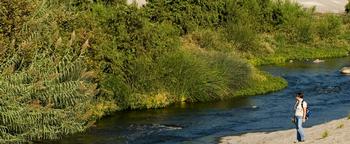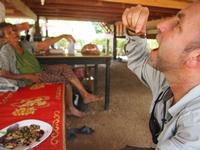2019 Invasive Lunch
 Didn't get enough of California Invasive Species Action Week? Only have 40 minutes? Want to feed your mind while you eat your lunch, or anytime at all? Videos from our 2019 series are posted below!
Didn't get enough of California Invasive Species Action Week? Only have 40 minutes? Want to feed your mind while you eat your lunch, or anytime at all? Videos from our 2019 series are posted below!
Webinar information - Join the Fun!
Click on the talk titles below to see the recorded webinars, or visit the UC California Naturalist YouTube Channel to see even more!
Monday-Tuesday-Wednesday
Killer algae, incestuous beetles, and rodents of unusual size
Monday, June 3: “How they get here: Aquatic invasive species being moved around the world”
Sabrina Drill, UC Cooperative Extension (presenting) and Edwin Grosholz, Dept. of Environmental Science and Policy, UC Davis
Most of us don’t hear about an invasive species until it is here causing problems. But preventing new invasive species from getting here in the first place requires understanding the “pathways” of introduction. From tsunamis to aquariums, container ships to canoes, Dr. Drill will discuss ways that freshwater and marine organisms travel to California.
Tuesday, June 4: “What’s killing California’s trees? Shot hole borers, palm weevils and the rest”
Beatriz Nobua-Behrmann, Urban Forestry and Natural Resources Advisor, UC Cooperative Extension
Tree pests come to Golden State from around the world and threaten street trees, agriculture, and natural areas. Last year the legislature in Sacramento allocated $5 million to begin addressing the latest threat – shot hole borers that kill a wide variety of trees in southern California. Dr. Nobua-Behrmann will describe how these insects damage trees and what we can do about it.
Wednesday, June 5: “Rodents of unusual size: Nutria in the Delta”
Valerie Cook-Fletcher, Nutria Eradication Incident Commander, Cal. Dept. of Fish & Wildlife
Nutria, a South American rodent, have caused extensive damage in Louisiana wetlands for decades. Now nutria have been found in the Sacramento-San Joaquin River Delta and its tributaries and state agencies are working to find them before they can breed and spread. Cook-Fletcher will provide an update on efforts to locate this elusive swimmer in the maze of sloughs and backwaters of California’s San Joaquin Valley.
Thursday-Friday
Weed-A-Palooza!
Mike Anciaux and Bob Simmons, Walnut Creek Watershed Council
Giant reed (Arundo donax) is one of the most damaging wildland weeds in California. More than $20 million was spent to remove it from the Santa Ana River watershed in southern California to protect the endangered Least Bell’s Vireo, a songbird that nests in native streamside vegetation. On the eastern side of San Francisco Bay, citizens are uniting to find and remove hundreds of populations along Contra Costa County’s creeks.
Bobbi Simpson, California Exotic Plant Management Team, National Park Service
Invasive knotweed species are some of the worst weeds in the world. They have become notorious for destroying property values in Europe. Knotweed is extremely difficult to get rid of because its underground rhizomes store energy and resist herbicides. Ms. Simpson will describe the partnership that has formed to eradicate recently-found invasive knotweed in the San Geronimo Valley and Lagunitas Creek watersheds in Marin County before it can spread.


